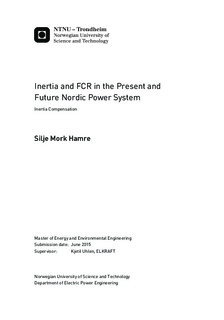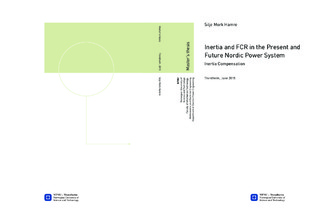| dc.description.abstract | The power system characteristics are changing and new power production in the Nordic countries is dominated by modern wind turbines and small scale hydro power. These are wind turbines that are electrically decoupled from the power grid through converters and hydro units below 10 MW with less inertia constants. In Sweden the nuclear power will most likely be reduced in the years to come. Towards 2020 the HVDC capacity connected to Norway will be more than doubled as two new 1400 MW cables to Germany and Great Britain will come in operation. Overall this results in less rotating mass in the power system, creating a lower inertia level. Whether this will be a problem or not is crucial for operational strategies and system security. Especially low load scenarios are of concern, e.g. a summer day with high import, relatively high wind production and where large hydro and thermal units are off-line.
There are requirements for the frequency reserves, but there are no requirements regarding inertia. Today the frequency containment reserves which are the primary reserves are organized as two separate mechanisms. FCR-N is for normal operation between 49.9-50.1 Hz with a requirement of 6000 MW/Hz, while FCR-D is for disturbances and is active between 49.9- 49.5 Hz with a requirement of 3000 MW/Hz. The FCR-D response should be 50 % activated in 5 seconds and 100 % activated in 30 seconds. In addition there are a transient limit of 49.0 Hz and a steady state limit of 49.5 Hz. The question is whether these requirements will secure sufficient levels of inertia or if other measures must be taken.
Possibilities of inertia compensation have been studied and simulated. Three alternatives were considered; synchronous condensers, synthetic inertia on wind turbines and synthetic inertia on HVDC. Synchronous condensers are a well established technology, while the synthetic inertia is a modern concept based on controls of power electronics and is still developing.
Simulations were conducted in PSS®E using an aggregated Nordic model (Nordic44). Three scenarios were considered. One of these was a reference scenario used to tune the model and included a recent outage of 1110 MW nuclear power in Sweden. Scenario 2 was a summer day from 2013 where production and load were low and import relatively high. This scenario was included to get an impression of the conditions today , as this is necessary to better estimate the future. The third scenario was a future scenario. The new HVDC cables in Norway were included and a summer day in 2020 with high import was considered in three versions. The first one (3a) has a share of production similar of today , the next (3b) was based on Statnett s worst case production portfolio including 20 % wind. The last one (3c) is similar, but includes the possibility of synthetic inertia on both the installed wind and the VSC HVDC cables.
When tuning the model response, several weaknesses of the Nordic44 model were revealed. First of all voltage levels and lines were not up to date. Second, different area division in the model made it difficult to distribute production and load data. At last the capacity in some areas had to be expanded. In total this resulted in a load flow not reflecting the real situation. The aim of the work was not to improve the model and the dynamic analyses were conducted without too many changes. The model is simple and advanced functions as HVDC emergency power and parameter changes on governors were not included. Voltage dependence of the load appeared to be another factor of great influence in the model. The voltage regulation in the model is most likely not sufficient and it is probably another model weakness. The above mentioned factors might influence the results of the simulations.
The same outage (1110 MW) was tested throughout the thesis. During the simulations both scenario 2 and 3 revealed low levels of inertia (135 to 104 GWs). Some outages (2 and 3b) were also simulated from an initial frequency of 49.9 Hz as a worst case scenario to check the FCR-D requirements. Doing so the frequency of both scenarios ended up below the transient limit, even though the outage was less than the dimension incident. Adjusting the droop settings mainly affected the steady state frequency. The FCR-D requirement of 50 % activation in five seconds was not met. Another option was considered; more hydro production on line at lower output. This increased both inertia and FCR and was therefore efficient. Anyway, this is not a desired way to increase the inertia as energy is assumed spilled. However this alternative met the 50 % activation after five seconds requirement with 40 % (of PMax) output on all hydro generators. This is remarkable as it does not reflect a realistic operation situation and is probably due to a slow model response.
For inertia compensation synthetic inertia appeared to be a better alternative than synchronous condensers. This is due to the low inertia constant of the synchronous condensers compared to the flexible gain value of the synthetic inertia. Furthermore, the synthetic inertia needs more attention, especially the possibilities on HVDC cables. In this thesis a simplification was made; the wind model was also used to model the synthetic inertia from HVDC. As only import is studied this is possible. The disadvantage is that since the wind model is based on the mechanics of a wind turbine, the power taken from the rotor must be recovered. This is not the case for HVDC cables as the connecting country can be assumed unlimited. Wind plans in Norway are rather unclear and the government s target of 3000-3500 MW installed wind within 2020 might be too optimistic. However, the mentioned 2800 MW HVDC cables will be built and are therefore a more realistic source of synthetic inertia in Norway.
Whether the FCR requirements will secure the levels of inertia is difficult to say from the model. The five second activation requirement seems to be very strict for these simulations using this model. Achieving 50 % after five seconds required lots of hydro power online at low output and this also coped with the other requirements. Anyway, this might be due to a slow model response and should not be seen as a finding. The structure of the FCR is a topic under investigation by the TSOs today. From these analyses the division between FCR-N and FCR-D do not seem to be optimal. Especially remarkable is how to relate the output requirement based on time with the requirement of frequency bias available. Clearer definitions of the different requirements or restructuring should be considered. As low inertia levels were reveled both in the past and future scenario action regarding inertia should be taken. A need to control the amount of inertia online is inherent. Therefore, possibilities for inclusion of inertia in the FCR market or creation of a separate market should be investigated. | |

